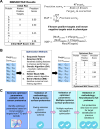This is a preprint.
IMMUNOTAR - Integrative prioritization of cell surface targets for cancer immunotherapy
- PMID: 38895237
- PMCID: PMC11185603
- DOI: 10.1101/2024.06.04.597422
IMMUNOTAR - Integrative prioritization of cell surface targets for cancer immunotherapy
Update in
-
ImmunoTar-integrative prioritization of cell surface targets for cancer immunotherapy.Bioinformatics. 2025 Mar 4;41(3):btaf060. doi: 10.1093/bioinformatics/btaf060. Bioinformatics. 2025. PMID: 39932005 Free PMC article.
Abstract
Cancer remains a leading cause of mortality globally. Recent improvements in survival have been facilitated by the development of less toxic immunotherapies; however, identifying targets for immunotherapies remains a challenge in the field. To address this challenge, we developed IMMUNOTAR, a computational tool that systematically prioritizes and identifies candidate immunotherapeutic targets. IMMUNOTAR integrates user-provided RNA-sequencing or proteomics data with quantitative features extracted from publicly available databases based on predefined optimal immunotherapeutic target criteria and quantitatively prioritizes potential surface protein targets. We demonstrate the utility and flexibility of IMMUNOTAR using three distinct datasets, validating its effectiveness in identifying both known and new potential immunotherapeutic targets within the analyzed cancer phenotypes. Overall, IMMUNOTAR enables the compilation of data from multiple sources into a unified platform, allowing users to simultaneously evaluate surface proteins across diverse criteria. By streamlining target identification, IMMUNOTAR empowers researchers to efficiently allocate resources and accelerate immunotherapy development.
Keywords: RNA-sequencing; bioinformatics; cancer; immunotherapy; pediatric cancer; proteomics.
Conflict of interest statement
Competing Interests: None
Figures






Similar articles
-
ImmunoTar-integrative prioritization of cell surface targets for cancer immunotherapy.Bioinformatics. 2025 Mar 4;41(3):btaf060. doi: 10.1093/bioinformatics/btaf060. Bioinformatics. 2025. PMID: 39932005 Free PMC article.
-
A proteogenomic surfaceome study identifies DLK1 as an immunotherapeutic target in neuroblastoma.bioRxiv [Preprint]. 2024 Jan 7:2023.12.06.570390. doi: 10.1101/2023.12.06.570390. bioRxiv. 2024. Update in: Cancer Cell. 2024 Nov 11;42(11):1970-1982.e7. doi: 10.1016/j.ccell.2024.10.003. PMID: 38106022 Free PMC article. Updated. Preprint.
-
Unraveling the surface proteomic profile of multiple myeloma to reveal new immunotherapeutic targets and markers of drug resistance.Cell Stress. 2022 Oct 13;6(11):89-92. doi: 10.15698/cst2022.11.273. eCollection 2022 Nov. Cell Stress. 2022. PMID: 36311892 Free PMC article.
-
[Development of antituberculous drugs: current status and future prospects].Kekkaku. 2006 Dec;81(12):753-74. Kekkaku. 2006. PMID: 17240921 Review. Japanese.
-
Advances in immunotherapy delivery from implantable and injectable biomaterials.Acta Biomater. 2019 Apr 1;88:15-31. doi: 10.1016/j.actbio.2019.02.016. Epub 2019 Feb 13. Acta Biomater. 2019. PMID: 30771535 Free PMC article. Review.
References
Publication types
Grants and funding
LinkOut - more resources
Full Text Sources
